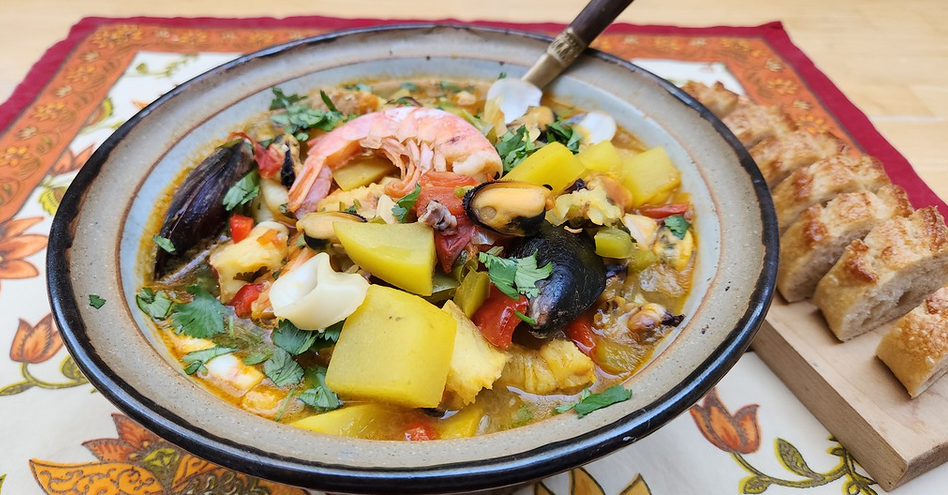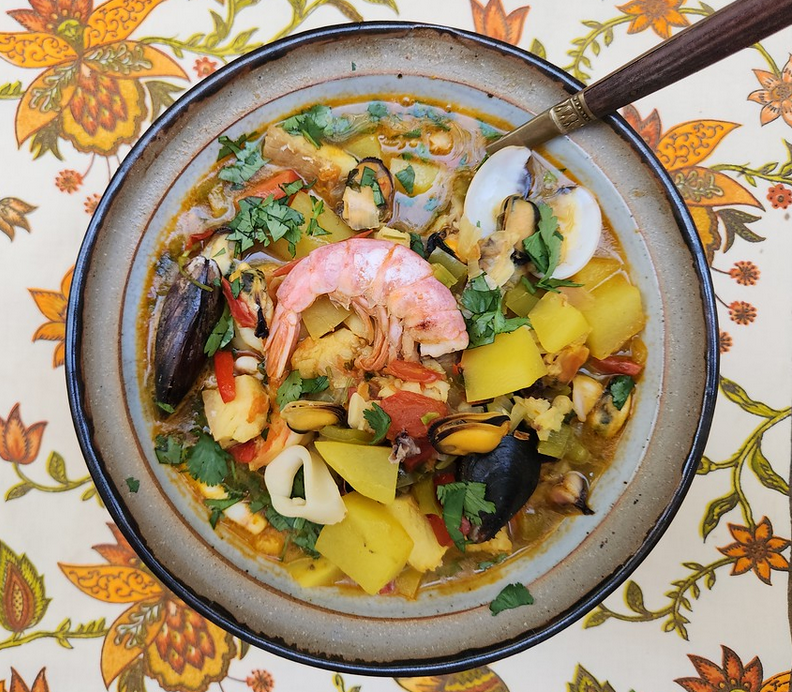The Participant Observer Recipe of the Month is Portuguese Caldeirada that combines fish, vegetables, and a saffron-infused broth for a deliciously satisfying repast. This recipe is easy to prepare and is guaranteed to warm your soul on a chilly night.

This month we return to Portugal for our monthly recipe. April is a significant month in Portugal. April 25 marks the 51st anniversary of the Carnation Revolution when a group of mid-level army soldiers, backed by widespread popular support, overthrew a decades-long brutal authoritarian and globe-spanning colonial regime in an almost entirely bloodless coup. The revolution earned its name from the sight of red carnations—inspired by a daring gesture from a restaurant worker named Celeste, who is said to have first placed a carnation in a soldier’s rifle, sparking a wave of similar acts throughout Lisbon. In the hours leading up to the uprising, the revolutionary military had pre-arranged secret signals to coordinate their actions. The first was the broadcast of “E Depois do Adeus” by Paulo de Carvalho (the Portuguese Eurovision entry for that year!), which served as the initial cue for soldiers to get into position. It was played by the Radio Clube Português station in Lisbon at exactly 10:55 PM. An hour and 15 minutes later, on April 25, “Grândola, Vila Morena” was played by radio stations throughout Portugal to alert soldiers to initiate the planned takeover.
The first year after the revolution was tumultuous, but then democracy and peace took root. While it is true that the country has comparatively low wages, successive governments have built a remarkable infrastructure including excellent free health care, well-kept roads and highways, advanced public transportation, and affordable schooling (yearly tuition for college students is between 600 and 1,200 Euros for public schools and up to 10,000 Euros for private colleges, which are few in number).
The old saying holds that “An army marches on its stomach,” and while there wasn't much marching during the Carnation Revolution, it is likely that many soldiers—and much of the populace—celebrated their liberation from tyranny with a warm and satisfying bowl of Caldeirada!
Caldeirada (which is derived from the Portuguese word for “cauldron,” a big pot) is similar to many soups and dishes found throughout the world; it’s a concoction made from whatever ingredients are close at hand rather than a highly specific and unique culinary expression. But what it lacks in uniqueness, it makes up for in deliciousness. Portugal is a maritime nation; its entire western border is the Atlantic Ocean. As such, a great number of Portuguese dishes make ample use of seafood. Oddly enough (until you understand why), salt cod (bacalhau) is the most used fish in Portugal and is typically imported from Scandinavia. For centuries, Portugal was a maritime empire, and salt cod could be loaded onto ships in ample amounts to provide sustenance for long ocean voyages. Over time, bacalhau became synonymous with Portuguese cuisine and is employed in a myriad of dishes throughout the country. But Caldeirada uses fresh seafood – and the more variety, the merrier!
Being named for and cooked in a large pot, Caldeirada is a stew suitable for large gatherings and celebrations. You can use any kind of firm fish that will not easily fall apart when being simmered. Cod, haddock, hake, monkfish, sea bass, grouper, or red snapper are all suitable choices. Calamari, along with shellfish (clams, mussels, shrimp, even lobster!) are also good additions. I used cod, shrimp, calamari, clams, and mussels, as those were the most available when I went shopping.
Cook's note: The most authentic stock for this dish is fish stock. But if you can't find fish stock, you can use vegetable or chicken stock, adding either a small bottle of clam juice (which is what I did) or a few tablespoons of fish sauce to achieve a rich seafood flavor.
Ingredients:
- About 1–1.5 pounds of mixed seafood
- 4 medium white or Yukon Gold potatoes, peeled and cubed
- 2 large onions, chopped
- 4 garlic cloves, minced or crushed
- 4 ripe tomatoes, chopped (or substitute with a 14.5 oz can of diced tomatoes)
- 1 red bell pepper, cubed
- 1 green bell pepper cubed
- 4 tablespoons olive oil
- 1/2 cup dry white wine
- 4 cups stock (see above)
- 1 bay leaf
- Large pinch of saffron
- 1/4 cup finely chopped cilantro stems
- Salt and freshly ground black pepper to taste
- A handful of chopped fresh cilantro for garnish
Preparation:
- In a large, heavy-bottomed pot, heat the olive oil over medium heat. Add the sliced onions and minced garlic, stirring until they soften and turn lightly golden.
- Add the bell peppers and cook for a few more minutes
- Add the chopped tomatoes to the pot. Let the mixture cook down for about 5 minutes so the tomatoes start breaking apart.
- Add the spices and stock.
- Add the potatoes.
- Bring to a gentle simmer and simmer for 10 minutes.
- Add the fish and simmer for 5 minutes.
- Add the shellfish and calamari, and simmer for 5 minutes.
Serve with crusty bread that you can dip into the stew.
Bom apetite!
Recipe and Photos: T. Johnston-O'Neill








